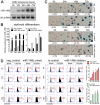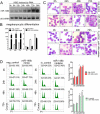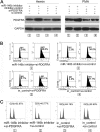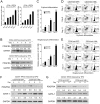The regulatory roles of microRNA-146b-5p and its target platelet-derived growth factor receptor α (PDGFRA) in erythropoiesis and megakaryocytopoiesis
- PMID: 24982425
- PMCID: PMC4132768
- DOI: 10.1074/jbc.M114.547380
The regulatory roles of microRNA-146b-5p and its target platelet-derived growth factor receptor α (PDGFRA) in erythropoiesis and megakaryocytopoiesis
Abstract
Emerging evidence has shown that microRNAs have key roles in regulating various normal physiological processes, whereas their deregulated expression is correlated with various diseases. The miR-146 family includes miR-146a and miR-146b, with a distinct expression spectrum in different hematopoietic cells. Recent work indicated that miR-146a has a close relationship with inflammation and autoimmune diseases. miR-146-deficient mice have developed some abnormal hematopoietic phenotypes, suggesting the potential functions of miR-146 in hematopoietic development. In this study, we found that miR-146b was consistently up-regulated in both K562 and CD34(+) hematopoietic stem/progenitor cells (HSPCs) undergoing either erythroid or megakaryocytic differentiation. Remarkably, erythroid and megakaryocytic maturation of K562 cells was induced by excess miR-146b but inhibited by decreased miR-146b levels. More importantly, an mRNA encoding receptor tyrosine kinase, namely platelet-derived growth factor receptor α (PDGFRA), was identified and validated as a direct target of miR-146b in hematopoietic cells. Gain-of-function and loss-of-function assays showed that PDGFRA functioned as a negative regulator in erythroid and megakaryocytic differentiation. miR-146b could ultimately affect the expression of the GATA-1 gene, which is regulated by HEY1 (Hairy/enhancer-of-split related with YRPW motif protein 1), a transcriptional repressor, via inhibition of the PDGFRA/JNK/JUN/HEY1 pathway. Lentivirus-mediated gene transfer also demonstrated that the overexpression of miR-146b promoted erythropoiesis and megakaryocytopoiesis of HSPCs via its regulation on the PDGFRA gene and effects on GATA-1 expression. Moreover, we confirmed that the binding of GATA-1 to the miR-146b promoter and induction of miR-146b during hematopoietic maturation were dependent on GATA-1. Therefore, miR-146b, PDGFRA, and GATA-1 formed a regulatory circuit to promote erythroid and megakaryocytic differentiation.
Keywords: Cell Differentiation; Erythropoiesis; GATA Transcription Factor; GATA-1; Hematopoiesis; Megakaryocytopoiesis; MicroRNA (miRNA); MicroRNA-146b; PDGFRA.
© 2014 by The American Society for Biochemistry and Molecular Biology, Inc.
Figures









Similar articles
-
A regulatory circuit comprising GATA1/2 switch and microRNA-27a/24 promotes erythropoiesis.Nucleic Acids Res. 2014 Jan;42(1):442-57. doi: 10.1093/nar/gkt848. Epub 2013 Sep 18. Nucleic Acids Res. 2014. PMID: 24049083 Free PMC article.
-
ZNF16 (HZF1) promotes erythropoiesis and megakaryocytopoiesis via regulation of the c-KIT gene.Biochem J. 2014 Feb 15;458(1):171-83. doi: 10.1042/BJ20130628. Biochem J. 2014. PMID: 24180487
-
A comprehensive analysis of GATA-1-regulated miRNAs reveals miR-23a to be a positive modulator of erythropoiesis.Nucleic Acids Res. 2013 Apr;41(7):4129-43. doi: 10.1093/nar/gkt093. Epub 2013 Feb 17. Nucleic Acids Res. 2013. PMID: 23420868 Free PMC article.
-
A regulatory network governing Gata1 and Gata2 gene transcription orchestrates erythroid lineage differentiation.Int J Hematol. 2014 Nov;100(5):417-24. doi: 10.1007/s12185-014-1568-0. Epub 2014 Mar 18. Int J Hematol. 2014. PMID: 24638828 Review.
-
GATA-1: one protein, many partners.Int J Biochem Cell Biol. 2006 Jan;38(1):6-11. doi: 10.1016/j.biocel.2005.06.017. Epub 2005 Jul 25. Int J Biochem Cell Biol. 2006. PMID: 16095949 Review.
Cited by
-
CREB1-driven expression of miR-320a promotes mitophagy by down-regulating VDAC1 expression during serum starvation in cervical cancer cells.Oncotarget. 2015 Oct 27;6(33):34924-40. doi: 10.18632/oncotarget.5318. Oncotarget. 2015. PMID: 26472185 Free PMC article.
-
Exosomal microRNA following severe trauma: Role in bone marrow dysfunction.J Trauma Acute Care Surg. 2024 Apr 1;96(4):548-556. doi: 10.1097/TA.0000000000004225. Epub 2023 Dec 28. J Trauma Acute Care Surg. 2024. PMID: 38151766 Free PMC article.
-
Comprehensive Analysis of microRNAs in Human Adult Erythropoiesis.Cells. 2021 Nov 4;10(11):3018. doi: 10.3390/cells10113018. Cells. 2021. PMID: 34831239 Free PMC article.
-
Deregulated miR-146a-3p alleviates disease progression in atherosclerosis through inactivating NF-κB: An experimental study.Medicine (Baltimore). 2024 May 17;103(20):e38061. doi: 10.1097/MD.0000000000038061. Medicine (Baltimore). 2024. PMID: 38758895 Free PMC article.
-
Expression and prognostic significance of microRNAs in Korean patients with myelodysplastic syndrome.Korean J Intern Med. 2019 Mar;34(2):390-400. doi: 10.3904/kjim.2016.239. Epub 2017 Nov 15. Korean J Intern Med. 2019. PMID: 29132200 Free PMC article.
References
-
- Gregory R. I., Chendrimada T. P., Cooch N., Shiekhattar R. (2005) Human RISC couples microRNA biogenesis and posttranscriptional gene silencing. Cell 123, 631–640 - PubMed
-
- Bushati N., Cohen S. M. (2007) microRNA functions. Annu. Rev. Cell Dev. Biol. 23, 175–205 - PubMed
-
- Ameres S. L., Zamore P. D. (2013) Diversifying microRNA sequence and function. Nat. Rev. Mol. Cell Biol. 14, 475–488 - PubMed
-
- Bartel D. P. (2004) MicroRNAs: genomics, biogenesis, mechanism, and function. Cell 116, 281–297 - PubMed
-
- Bernstein E., Kim S. Y., Carmell M. A., Murchison E. P., Alcorn H., Li M. Z., Mills A. A., Elledge S. J., Anderson K. V., Hannon G. J. (2003) Dicer is essential for mouse development. Nat. Genet. 35, 215–217 - PubMed
Publication types
MeSH terms
Substances
LinkOut - more resources
Full Text Sources
Other Literature Sources
Medical
Research Materials
Miscellaneous

